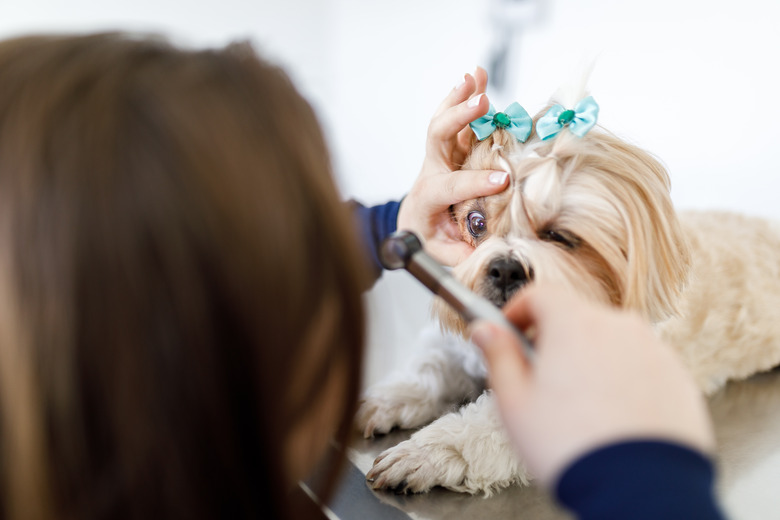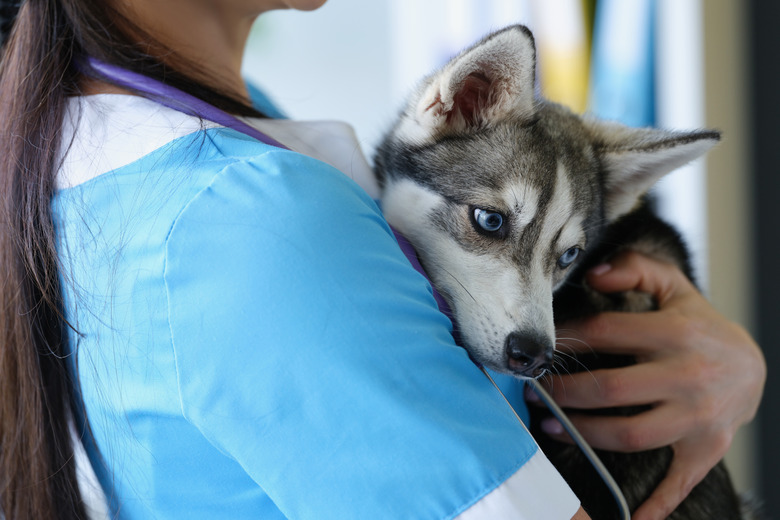Tobramycin Eye Drops For Dogs: Uses, Dosage & Side Effects
Treating Dog Eye Infections With Tobradex
Tobradex is the brand name for a prescription medication that is a combination of the dog-safe antibiotic tobramycin (brand name Tobrex) and the steroid dexamethasone. Tobradex is made by Alcon Labs. The tobramycin ophthalmic solution combined with dexamethasone creates a powerful treatment for dogs battling eye infections.
Tobradex is a medication originally made and FDA-approved for treating human eye infections. But while Tobradex is not specifically made for dogs, many veterinarians turn to it as a safe and effective solution to treat eye infections in dogs.
From conjunctivitis and bacterial eye infections to hypersensitivity of the eye and other ocular issues, there are many conditions that will require eye medication. Some ophthalmic infections, such as minor redness of the eye, may even respond to simple home remedies or over-the-counter eye drops. However, eye infections always require a veterinarian visit, as only your veterinarian can determine the cause and necessary treatment for your dog's eye infection.
How tobramycin and dexamethasone treat canine eye infections
How tobramycin and dexamethasone treat canine eye infections
The tobramycin component of Tobradex aggressively kills certain gram-positive and gram-negative bacteria that invade a dog's eye. The tobramycin ophthalmic solution can fight such bacterial infections as Staphylococcus aureus, certain Streptococcus species, Pseudomonas aeruginosa, and Klebsiella pneumoniae, to name a few. "The dexamethasone component is added to reduce swelling and irritation often associated with bacterial infections," says Dr. Shagufta Mulla, a veterinarian with a DVM degree from Colorado State University with 20 years of experience as a small animal veterinarian.
Tobradex formats for dogs
Tobradex formats for dogs
Tobradex comes in two different formats: eye drops and an ophthalmic ointment. Each millimeter contains 0.3 percent tobramycin and 0.1 percent dexamethasone. When using the tobramycin ophthalmic solution, the tobramycin eye drops need to be shaken before use because the active ingredients settle to the bottle's bottom. Both forms of Tobradex can be purchased only if you have access to a prescription from your veterinarian.
Administering Tobradex to my dog
Administering Tobradex to my dog
To administer eye drops, hold the Tobradex bottle near the dog's eye, being careful not to touch the surface. Squeeze the dropper carefully, dispensing the correct number of drops on the center part of the affected eye. The dog's blinking will help to spread the medication more thoroughly across the entire eye.
To administer Tobradex in the ophthalmic ointment format, use your thumb and index finger to gently open your dog's eye and squeeze the ointment carefully onto the inside of the lower lid. Whether using eye drops or ointment, it's important to wash your hands both before and after administering the medication to avoid contamination and prevent the possible spread of infection.
Proper dosage of Tobradex for dogs
Proper dosage of Tobradex for dogs
As with many drugs used in veterinary medicine, Tobradex is a human drug, but because of veterinary research, a range of dosing standards have been set for dogs. Which dosage to use is determined by a veterinarian and is based on the particular dog's needs. The goal is to give the smallest possible amount of this prescription antibiotic that will control the infection and not produce negative side effects.
Tobradex side effects in dogs
Tobradex side effects in dogs
As with any medication, Tobradex can lead to potential side effects. Possible side effects that could happen within the first few days include:
- itchy eyes
- swollen eyelids
- an increase in redness of the eyelid or the pink lining of the eyelids (the conjunctiva)
- facial swelling
- severe diarrhea
- vomiting
Possible long-term side effects include a secondary eye infection because of the suppression of the immune system, deafness, coordination problems resulting from inner ear damage, kidney damage, or liver damage.
"Outside of secondary infection, these side effects are more likely to occur when a systemic antibiotic of the same category as tobramycin is used, for example, an aminoglycoside," explains Dr. Mulla. Tobradex may also cause a dog already on diuretics to become quickly dehydrated. If your dog is on a diuretic, be sure to discuss this with your veterinarian.
Tobradex cautions for dogs
Tobradex cautions for dogs
"The systemic absorption of tobramycin is fairly low," explains Dr. Mulla. "And with the exception of pregnant dogs, it's generally considered safe when used ophthalmically as long as systemic aminoglycoside antibiotics aren't also being used." Speak with your veterinarian to discuss any other risk factors, such as if your dog has liver or kidney problems.
Tobradex, like many medications, can be ordered online as long as you have a prescription. You can read customer reviews online and sometimes find coupons at checkout or get special discounts for autoship if your veterinarian believes your dog will need more than one course of treatment for the topical antibiotic. However, it's important to follow up with your veterinarian to ensure the best possible treatment for your dog.
The bottom line
The bottom line
Tobradex, a combination of the antibiotic tobramycin (brand name Tobrex) and the steroid dexamethasone, is a drug originally created to treat human eye infections. Veterinarians now prescribe it as a safe and effective solution to treat eye infections in dogs. Tobradex is available in an ophthalmic suspension eye drop format and an ointment format. While Tobradex is generally considered safe for dogs (with the exception of pregnant dogs), you should speak to your veterinarian if your dog has liver or kidney problems or if your dog shows side effects such as itchy eyes, swollen eyelids, facial swelling, severe diarrhea, or vomiting.


